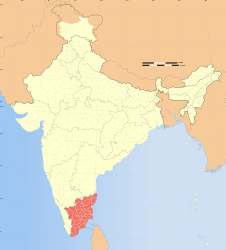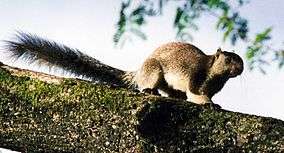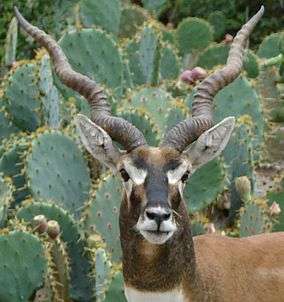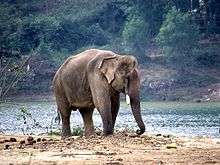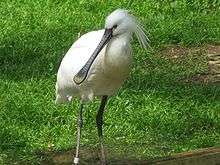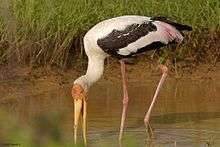Protected areas of Tamil Nadu
(Tamil:தமிழ்நாட்டின் பாதுகாக்கப்பட்ட பகுதிகள்),the Protected areas of Tamil Nadu State in South India cover an area of 3,305 km2 (1,276 sq mi), constituting 2.54% of the geographic area and 15% of the 22,643 km2 (8,743 sq mi) recorded forest area. It ranks 14th among all the States and Union Territories of India in terms of total protected area.[1]
The major protected areas include 3 Biosphere reserves, 5 National parks, 8 Wildlife sanctuaries, 4 elephant reserves, 4 Tiger Reserves and 13 Bird sanctuaries. These protected areas of the state contain viable populations of threatened wildlife, keystone species and endemic species and cover significant eco-system types, habitats, landscapes and wildlife corridors. These protected areas of the state are mainly managed for conservation of biodiversity, education, recreation, and preservation of historic sites, unique landscapes and seascapes.[2]
Creation and administration of Protected areas in South India originated with the Maharajas of the Southern Princely States' private hunting grounds. The Mudumalai National Park, established in 1940, was the first modern Wildlife Sanctuary in South India. Most protected areas throughout its 30 Districts are under the stewardship of the Ministry of Environment and Forests (India) and the Tamil Nadu Forest Department.[3]
| Map Key: |
Biosphere Reserve |
National Park |
Wildlife Sanctuary |
Bird Sanctuary |
Zoo |
|---|
Biomes
| Part of a series on the |
| Wildlife of India |
|---|
 |
|
Biodiversity |
|
|
Organisations
|
|
Related topics |
|
The state includes a wide range of biomes, extending east from the South Western Ghats montane rain forests in the Western Ghats through the South Deccan Plateau dry deciduous forests and Deccan thorn scrub forests to tropical dry broadleaf forests and then to the beaches, estuaries, salt marshes, mangroves, and coral reefs of the Bay of Bengal.
Flora
The Angiosperm diversity of India includes 17,672 species. Tamil Nadu ranks 1st among all the States in the Country with 5640 species (32%). This includes 533 endemic species, 230 red-listed species, 1559 species of medicinal plants and 260 species of wild relatives of cultivated plant. The Gymnosperm diversity of the country is 64 species of which Tamil Nadu has 4 species (6%) of indigenous Gymnosperms and about 60 introduced species. The Pteridophytes diversity of India includes 1022 species of which Tamil Nadu has about 184 species (18%).[5]
Fauna
The faunal diversity of Tamil Nadu includes 165 species of fresh water fish of which 126 (76%) are red listed, 76 species of Amphibians of which 56 (74%) are red listed, 177 species of Reptiles of which 77 (44%) are red listed, 454 species of Birds of which 32 are red listed and 187 species of Mammals of which 40 (21%) are red listed. The endemic fauna includes 36 species of Amphibians, 63 species of reptiles, 17 species of birds and 24 species of mammals.[6]
Biosphere Reserves
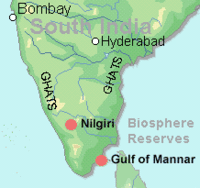
Two of the three Biosphere Reserves in Tamil Nadu are among four in India and ninety five in Asia that are part of UNESCO's Programme on Man and the Biosphere (MAB).
The 3 Biosphere Reserves in Tamil Nadu listed by size are:
- The Gulf of Mannar Biosphere Reserve, is 10,500 km2 (4,100 sq mi). located in the Indian part of the Gulf of Mannar between the Tamil Nadu and Sri Lanka Coasts. Est. 1989.
- Nilgiri Biosphere Reserve is located in the Western Ghats and Nilgiri Hills. The reserve encompasses 5,520 km2 (2,130 sq mi). in the states of Tamil Nadu (2537.6 km²), Karnataka (1527.4 km²) and Kerala (1455.4 km²).
- Agasthyamalai Biosphere Reserve (ABR) was Established in 2001 and now includes 3,500.36 km2 (1,351.50 sq mi). ABR is awaiting approval as participant in the UNESCO-Man and the Biosphere (MAB) Programme.[7]
National Parks
of Tamil Nadu
Tamil Nadu has 5 declared National Parks with a total area over 307.84 km2 (118.86 sq mi), covering only 0.24% of the state. This is the third lowest % area covered of all Indian states and Union territories.[8]
- Indira Gandhi National Park (previously: Aanamalai National Park), 117.10 km2 (45.21 sq mi), Est. 1989.
- Mudumalai National Park 103.24 km2 (39.86 sq mi), Est. 1990
- Mukurthi National Park 78.46 km2 (30.29 sq mi), Est. 1982
- Gulf of Mannar Marine National Park 6.23 km2 (2.41 sq mi), Est. 1980
- Guindy National Park 2.82 km2 (1.09 sq mi), Est. 1976[9]
- Palani Hills National Park 736.87 km2 (284.51 sq mi) (PRO) is a proposed upgrade of the Kodaikanal Wildlife Sanctuary being established in 2008
Wildlife Sanctuaries
There are 7 wildlife sanctuaries plus 13 bird sanctuaries that together cover over 2,997.60 km2 (1,157.38 sq mi), 2.30% of the total state area.[10]
- Grizzled Squirrel Wildlife Sanctuary, a 485 km2 (187 sq mi) Giant Squirrel Sanctuary near Srivilliputhur,in Virudhunagar district consisting of mainly dry deciduous forests with patches of tropical evergreen forests, semi-evergreen forests, moist mixed deciduous forests and grassland. Grizzled giant squirrel, flying squirrel, tree shrew, elephant, lion-tailed macaque, Nilgiri tahr, mouse deer, barking deer and many species of birds may be seen.
- Indira Gandhi Wildlife Sanctuary is contiguous with Indira Gandhi National Park in Coimbatore District. The 841.49 km2 (324.90 sq mi) forest varies from dry deciduous to semi-evergreen, evergreen and montane wet temperate containing teak, rose wood and other tropical species. Animals, including Indian elephant, gaur, tiger, panther, sloth bear, wild boar, dhole, Nilgiri langur, lion-tailed macaque, sambar, four horned antelope, chital and a host of birds, notably the trogar, pied hornbill and several types of eagles may be seen.
- Kalakkad Wildlife Sanctuary in Tirunelveli District is part of the Kalakkad Mundanthurai Tiger Reserve. This 223.58 km2 (86.32 sq mi) forest consists of mostly tropical wet evergreen forests which change to tropical dry deciduous forests in the foothills and to thorn forests further down. This sanctuary is famous for lion-tailed macaque. All four species (common langur, Nilgiri langur, bonnet macaque and lion tailed macaque) can be seen. Other animals include Nilgiri tahr, sambar, sloth bear, gaur, Indian elephant, tiger, flying squirrel, panther, dhole, pangolin and a variety of birds and reptiles.
- Mundanthurai Sanctuary 282.08 km2 (108.91 sq mi) in Tirunelveli District, is part of Kalakkad Mundanthurai Tiger Reserve.
- Kanyakumari Wildlife Sanctuary is a 457.78 km2 (176.75 sq mi) tiger habitat in Kanyakumari district declared a sanctuary in February 2008.
- Mudumalai Wildlife Sanctuary in Nilgiris district is contiguous with Mudumalai National Park. It consists of 217.76 km2 (84.08 sq mi) primarily moist deciduous forest which becomes dry deciduous towards Bandipur including mainly mixed forests with bamboos. Animals including elephant, gaur, sambar, chital, dhole panther, tiger, sloth bear, python, barking deer, four-horned antelope, common langur, otter, crocodiles (mugger) and a variety of birds and reptiles may be seen.
- Sathyamangalam Wildlife Sanctuary in Erode district, 1,411.6 km2 (545.0 sq mi), the largest wildlife sanctuary in Tamil Nadu, was declared a sanctuary in 2008.[11][12] The sanctuary was later declared as a Tiger Reserve due to large number of tigers sighted during the 2010 wildlife survey.[12][13][14]
- Vallanadu Wildlife Sanctuary, a 16.41 km2 (6.34 sq mi) black buck antelope sanctuary in Thoothukudi District, is a scrub forest where black buck, spotted deer, macaques, jungle cat, mongoose, and hares may be seen.[15]
As of 2006, there were an additional 18 proposed sanctuaries totaling 2,957.52 km2 (1,141.90 sq mi) awaiting declaration.[16]
Elephant reserves
Tamil Nadu is a major participant in Project Elephant. It has 5 elephant sanctuaries covering 7,940 km2 (3,070 sq mi) with 6776 elephants in 2005, 19 elephant corridors and 4 inter-state corridors linking to elephant sanctuaries in Karnataka.[17] There are 14 Forest Department divisions containing elephants.[18]
- Nilgiri Elephant Reserve, 4,663 km2 (1,800 sq mi), protected area 716 km2 (276 sq mi), elephant population 1938, contiguous with Wayanad Reserve in Kerala, Mysore reserve in Karnataka and Rayala reserve in Andhra Pradesh, established 2003.
- Coimbatore Elephant Reserve, 566 km2 (219 sq mi), protected area 482 km2 (186 sq mi), elephant population 132, contiguous with Nilambur Reserve in Kerala, established 2003.
- Anamalai Elephant Reserve 1,457 km2 (563 sq mi), protected area 300 km2 (120 sq mi), elephant population 680, contiguous with Anamalai Reserve in Kerala, established 2003.
- Srivilliputtur Elephant Reserve, 1,249 km2 (482 sq mi), protected area 568 km2 (219 sq mi), elephant population 223, contiguous with Periyar Reserve in Kerala, established 2002.
Tiger reserves
Though The 2008 census indicated a decline in tiger population all over India, the only exception was in Tamil Nadu where the animals' numbers have increased to 76 from 60 five years ago.[19][20] Tamil Nadu has 4 tiger reserves which are declared as part of Project Tiger:
- Kalakkad Mundanthurai Tiger Reserve - Established in 1962, this 900 km2 (350 sq mi) reserve in Tirunelveli district is now part of the Agasthyamalai Biosphere Reserve. It was adopted by Project Tiger in 1988.[21] The Ashoka Trust for Research in Ecology and the Environment (ATREE) has developed and implemented a conservation intervention program here.[22] A comprehensive report on the history, flora & fauna, ecology and future of the reserve is available.[23] This reserve has an estimated tiger population of 6-8 tigers.[20]
- Mudumalai National Park was declared to be a tiger reserve in April, 2007, under section 38V of the Wildlife Protection Act of 1972, in an effort to conserve the country's dwindling tiger populations. Subsequently, about 350 families living in the core area have been evicted from the park and given 1 million rupee ($20,800) compensation. Those in the 5 km buffer area around the park will be involved in the project as trackers and guides to enhance their income through eco-tourism.[24] Tigers occupy 5,326 square kilometres (2,056 sq mi) of this reserve with an estimated tiger population of 62 (44 to 80) tigers.[20]
- Anaimalai-Parambikulam Tiger Reserve, including Indira Gandhi National Park in Tamil Nadu, was declared as a Tiger Reserve in 2008.[25] This reserve has tiger occupancy in 2,744 km2 (1,059 sq mi) within a contiguous forest patch of 4,400 km2 (1,700 sq mi). Within Tamil Nadu, tigers occupied 1,691 km2 (653 sq mi) with an estimated population of 6-8 tigers.[20]
- Sathyamangalam Tiger Reserve, in Erode district with 1,411.6 km2 (545.0 sq mi), is the largest wildlife sanctuary in Tamil Nadu encompassing areas of Gobichettipalayam and Sathyamangalam talukas .[26] It was declared as a tiger reserve in 2011 and had a population of 46 tigers in the 2010 wildlife survey.[12][13][14] during month of March 2013.
Bird sanctuaries
There are 13 established bird sanctuaries at the southernmost continental range of the Central Asian Flyway in Tamilandu.[27][28]
- Chitrangudi Bird Sanctuary - This .48 km2 (0.19 sq mi) sanctuary in Ramanathapuram District is home to spot-billed pelicans, cormorants, egrets, grey heron, spoon-billed stork. 9°19′48″N 78°29′23″E / 9.33000°N 78.48972°E[29]
- Kanjirankulam Bird Sanctuary - This 1.04 km2 (0.40 sq mi) sanctuary in Ramanathapuram District is home to cormorants, egrets, grey heron, spoon-billed storks, teals and pelicans.
- Karaivetti Bird Sanctuary - This 4.54 km2 (1.75 sq mi) sanctuary in Perambalur District is home to egrets, pelican, grey heron, black-headed ibis and common spoonbills.
- Karikili Bird Sanctuary - This .612 km2 (0.236 sq mi) sanctuary in Kancheepuram Districtis home to cormorants, egrets, grey heron, spoon-billed stork.
- Koothankulam Bird Sanctuary - This 1.2933 km2 (0.4993 sq mi) in Nanguneri Taluk of Tirunelveli district is the largest reserve for breeding water birds in South India and attracts more than 100,000 birds annually.
- Melaselvanur - Kilaselvanur Bird Sanctuary - This 5.93 km2 (2.29 sq mi) sanctuary in Ramanathapuram District is home to grey pelican and painted stork.[30]
- Point Calimere Wildlife and Bird Sanctuary - is a 17.26 km2 (6.66 sq mi) bird sanctuary In Point Calimere, Nagapattinam district. It consists of tidal swamps, dry evergreen forests and mangroves. The sanctuary is famous for its flamingos and black buck antelope. A large variety of water birds including teals, gulls, terns, plovers and stilts can be seen during winter months. Mammals include chital, wild boar. The water birds of the great swamp and the dolphins and turtles that often come close to the shore are important attractions.
- Pulicat Lake Bird Sanctuary - This 461.02 km2 (178.00 sq mi) sanctuary in Pulicat, Thiruvallur District is the second largest brackish-water eco-system on the East Coast of India. Many greater flamingos can be seen here.
- Udayamarthandapuram Bird Sanctuary - is .45 km2 (0.17 sq mi) in Tiruvarur District. It is home to little cormorant, darter, spoon bill, Indian reef heron, grey heron, whitenecked stork
- Vaduvoor Bird Sanctuary - This 1.28 km2 (0.49 sq mi) sanctuary is 14 km from Mannargudi towards Thanjavur in Thiruvarur district It consists of a fresh water lake with a few trees, mainly babul. There are 40 different species of birds including: river tern, tricoloured munia, grey heron, white-breasted kingfisher spotted dove and more. Annual rainfall is about 1400 mm. The nearest airport is at Thiruchirapalli and the nearest railway station is Thanjavur. There is a rest house at Mannargudi.[31]
- Vedanthangal Bird Sanctuary - This .3 km2 (0.12 sq mi) sanctuary in Kancheepuram District is home to cormorants, egrets, gray heron, spoon-bill stork and migratory birds such as garganey, teals, shovellers
- Vellode Birds Sanctuary - This .772 km2 (0.298 sq mi) sanctuary in Erode District is home to spoon bills, teals, pintail ducks, and darters.
- Vettangudi Bird Sanctuary - This .344 km2 (0.133 sq mi) near Thirupattur in Sivaganga district has attracted more than 8,000 migratory birds belonging to 217 species, mostly from European and North Asian countries. The species included white ibis, Asian openbill stork and night heron. It has also attracted indigenous, endangered species such as painted stork, grey heron, darter, little cormorant, little egret, intermediate egret, cattle egret, common teal, spotbills, pintail and flamingos. The government has allotted Rs. 9 lakhs for the Vettangudi Sanctuary to improve infrastructure for tourists.
- Viralimalai Peacock Sanctuary - This is in the small town of Viralimalai, situated 30 km from Thiruchirapalli and 40 km from Pudukkottai. It is known for its Murugan temple and the adjacent Peacock Sanctuary. The town is bestowed with a large number of wild peacocks, which roam around the Murugan temple.[32] The town, Temple and Peacock Sanctuary have been declared and funded as a Heritage Place by order of the governor.[33]
- Kallaperambur lake 10°47′51″N 79°01′36″E / 10.79750°N 79.02667°E near Thanjavur has recently been declared as a bird sanctuary by the Forest Department. Improvement works remain to be undertaken in the lake.[34]
- Suchindram Theroor Birds Sanctuary is a proposed protected area comprising the Suchindram Kulam wetlands at 8°7′30″N 77°27′30″E / 8.12500°N 77.45833°E, and the Theroor Kulam at 8°10′45″N 77°27′45″E / 8.17917°N 77.46250°E, both near Suchindram town in Kanyakumari District. It is located between Nagercoil and Kanyakumari on the National Highway No. 47. Being at the extreme southern tip of India, this area is the southernmost bird sanctuary in the continental range of the Central Asian Flyway.
Conservation reserves and community reserves
- Tiruvidaimarudur Conservation Reserve is in the .0284 km2 (0.0110 sq mi) compound of the Mahalingha Swamy Siva temple[35] in Tiruvidaimarudur village, Thanjavur District. Over 400 little egrets, pond heron and painted stork nest and feed in this area adjacent to the Tamiraparani River, 10 km. from Kalakkad Mundanthurai Tiger Reserve.[36]
Zoos
There are two zoos recognised by the Central Zoo Authority of India in Tamil Nadu.
- Arignar Anna Zoological Park is 5.10 km2 (1.97 sq mi) in Chennai.
- Madras Crocodile Bank Trust, a reptile zoo and herpetology research station, located 40 km south of Chennai.[37] There are many small zoos across the state run by local administrative bodies such as Coimbatore Zoo in Coimbatore, Amirthi Zoological Park in Vellore, Kurumpampatti Wildlife Park in Salem district, Yercaud Deer Park in Yercaud, Mukkombu Deer Park in Tiruchirapalli district and Ooty Deer Park in Nilgiris district
Crocodile Farms
There are five Crocodile farms in Tamil Nadu, four under the control of Forest Department.[38]
- Amaravati Sagar Crocodile Farm, Coimbatore district
- Hogenakkal Crocodile Bank, Dharmapuri district
- Kurumbapatti Crocodile farm, Salem district
- Madras Crocodile Bank Trust, Chennai
- Sathanur Dam Crocodile Bank, Tiruvannamalai district
Regional Cooperation
Senior forestry officials cooperate on mutual issues concerning conservation and protection of forests and wildlife of the region. A regular conference of the forest ministers and forest officials of the southern states is held once a year, in rotation in each State. The Forest Ministers of Kerala, Tamil Nadu, Andhra Pradesh and Karnataka, senior officials of the Ministry of Environment and Forests, Government of India, Forest Secretaries of Tamil Nadu and Kerala, Special Secretary for Forests, Andhra Pradesh, Principal Chief Conservator of Forests of Kerala, Tamil Nadu, Andhra Pradesh and Karnataka, together with the senior forest officials of these states and the Union Territory of Pondicherry, met at Thiruvananthapuram on November 3 and 4, 2006 and resolved several mutual issues concerning conservation and protection of forests and wildlife of the region. This formalization of interstate cooperation on protected areas administration improves effectiveness in the areas of: daily staff communication including common wireless frequencies, joint enforcement action, boundary survey and demarcation, management of cross border resources like Biosphere Reserves, National Parks, Tiger reserves and Wildlife Sanctuaries, technology, staff and intelligence sharing and coordinated communication with the Govt. of India, especially allotting more funds for conservation and forestation activities of State Forest Departments by the Union Government.[39] The second meeting was held at Bangalore on September 21 and 22, 2007.[40] The third meeting was held at Hyderabad on October 25 and 26, 2008.[41]
References
- ↑ Tamil Nadu Forest Dept. Wild Biodiversity
- ↑ Tamil Nadu Ministry of Environment and Forests, Policy note, 2006-2007, Demand No. 15, Forest Dept., Page 4. Policy Note
- ↑ Tamil Nadu Forest Dept. Forests.tn.nic.in Home Page
- ↑ Tamil Nadu Forest Dept.Eco-Tourism
- ↑ Tamil Nadu Forest Dept. Floral Diversity
- ↑ Tamil Nadu Forest Dept., Retrieved 9/9/2007, Forests.tn.nic.in, Faunal Diversity
- ↑ Tamil nadu Forest Dept., Retrieved 9/9/2007 Biosphere Reserves
- ↑ Wildlife Institute of India, National Wildlife Database (November 2006), retrieved 3/25/2007 National Parks
- ↑ Tamil Nadu Forest Dept., Retrieved 9/9/2007 National Parks
- ↑ National Wildlife Data Center (June 2008). "State-wise break up of Wildlife Sanctuaries". Wildlife Institute of India. Retrieved 2007-03-26.
- ↑ "Sathyamangalam forests declared as sanctuary". Chennai, India: The Hindu. 24 December 2008. Retrieved 2009-04-14.
- 1 2 3 B. Aravind Kumar (2011-09-27). "Sathyamangalam wildlife sanctuary expanded to 1.41 lakh hectares". The Hindi, Chennai. Kasturi & Sons Ltd. Retrieved 2011-09-27.
- 1 2 "Over 100 tigers spotted in three tiger reserves, says forest minister -". The Times of India, Chennai. Bennett, Coleman & Co. Ltd. 2010-10-24. Retrieved 2011-01-02.
- 1 2 "Veerappan lair now a tiger den". The Times of India, Chennai. Bennett, Coleman & Co. Ltd. 2010-09-30. Retrieved 2011-01-03.
- ↑ Tamil nadu Forest Dept
- ↑ National Wildlife Data Center (2006). "List of Proposed Wildlife Sanctuaries in India" (PDF). Wildlife Institute of India. Retrieved 2007-03-26.
- ↑ Ministry of Environment and Forests, 2005.Project Elephant
- ↑ Asian Nature Conservation Foundation, Maps & Data.Forest Divisions of South India bearing Elephants
- ↑ "India tiger population declines". South Asia. BBC News. 2008-02-13. Retrieved 25 November 2009.
- 1 2 3 4 Qamar Qureshi; K. Sankar; Rajesh Gopal; Y.V. Jhala (2008). "Western Ghats Landscape Complex/Tamil Nadu". Status of Tigers, Co-Predators and Prey in India (PDF). National Tiger Conservation Authority, Ministry of Environment & Forests, New Delhi and Wildlife Institute of India, Dehradun. pp. 72–94.
- ↑ Project Tiger /Kalakkad
- ↑ Ashoka Trust for Research in Ecology and the Environment Community interventions in Kalakad Mundanthurai Tiger Reserve
- ↑ Johnsingh, A. J. T., Wildlife Institute of India, "The Kalakad–Mundanthurai Tiger Reserve: A global heritage of biological diversity", Current Science, VOL. 80, NO. 3, 10 February 2001. Kalakad–Mundanthurai Tiger Reserve
- ↑ Murari, S. (31-Dec-08). "Thousands Protest Against Indian Tiger Reserve". Planet Ark. Reuters. Retrieved 2009-10-30. Check date values in:
|date=(help) - ↑ "Eight New Tiger Reserves". Press Release. Ministry of Environment and Forests, Press Information Bureau, Govt. of India. November 13, 2008. Retrieved 2009-10-31.
- ↑ "Sathyamangalam forests declared as sanctuary". Chennai, India: The Hindu. 24 December 2008. Retrieved 2009-04-14.
- ↑ Tamil Nadu Department of Environment (2006) State of the Environment, retrieved 9/9/2007, Report
- ↑ Tamil Nadu Forest Dept., Bird sanctuaries
- ↑ UNEP
- ↑ Migratory birds flock to Vettangudi Sanctuary, The Hindu, 9/11/2005, Hinduonnet.com, Vettangudi
- ↑ Tamil Nadu Forest Dept., Bird Sanctuaries in Tamil Nadu Vaduvoor
- ↑ Tamildnadu Tourism Development Corporation and Department of Tourism, retrieved 5/21/2007 Viralimalai Sanctuaries
- ↑ Rural Development and Panchayat Raj (PR.2) Department, G.O. (Ms) No.19, Dated: 23.1.2008 TNRD.gov.in, Declaring Viralimalai as a heritage place
- ↑ The Hindu, Hindu.com, December 15, 2005
- ↑ Indian Temples, Mahatiru
- ↑ Tamil Nadu Forest Dept (2007) Wild Biodiversity, retrieved 9/9/2007, Forests.tn.nic.in, Tiruppadaimarathur Conservation Reserve
- ↑ Tamil Nadu Forest Dept. Zoos
- ↑ TNU/WLTCrocFarm, ENVIS, TNU Crocodile Farms
- ↑ Conference of the Forst Ministers of Southern States, Thiruvananthapuram, 3 – 4 November 2006 Resolution
- ↑ Two-day meet of Forest Ministers concludes
- ↑ "Southern Forest Ministers' meet for tax on forest produce". The Hindu. Chennai, India: Kasturi & Sons Ltd. 2008-10-27. Retrieved 17 April 2010.
External links
- About Tamil Nadu Department of Forests
- page 13, United Nations List of National Parks and Protected Areas: India (2002)
- Ministry of Forests and Environment Protected Areas
- Ministry of Environment and Forests, 2006 Report

